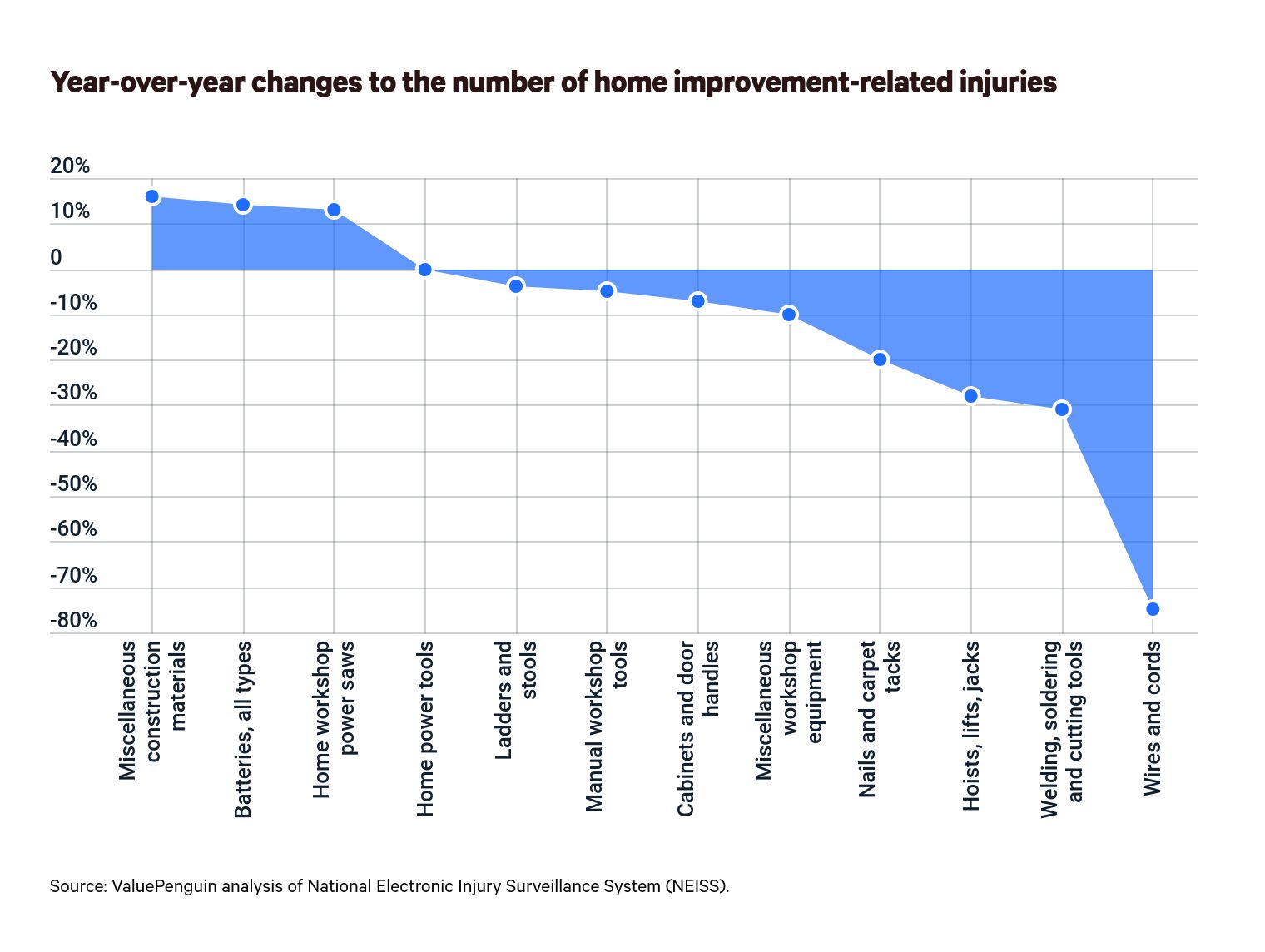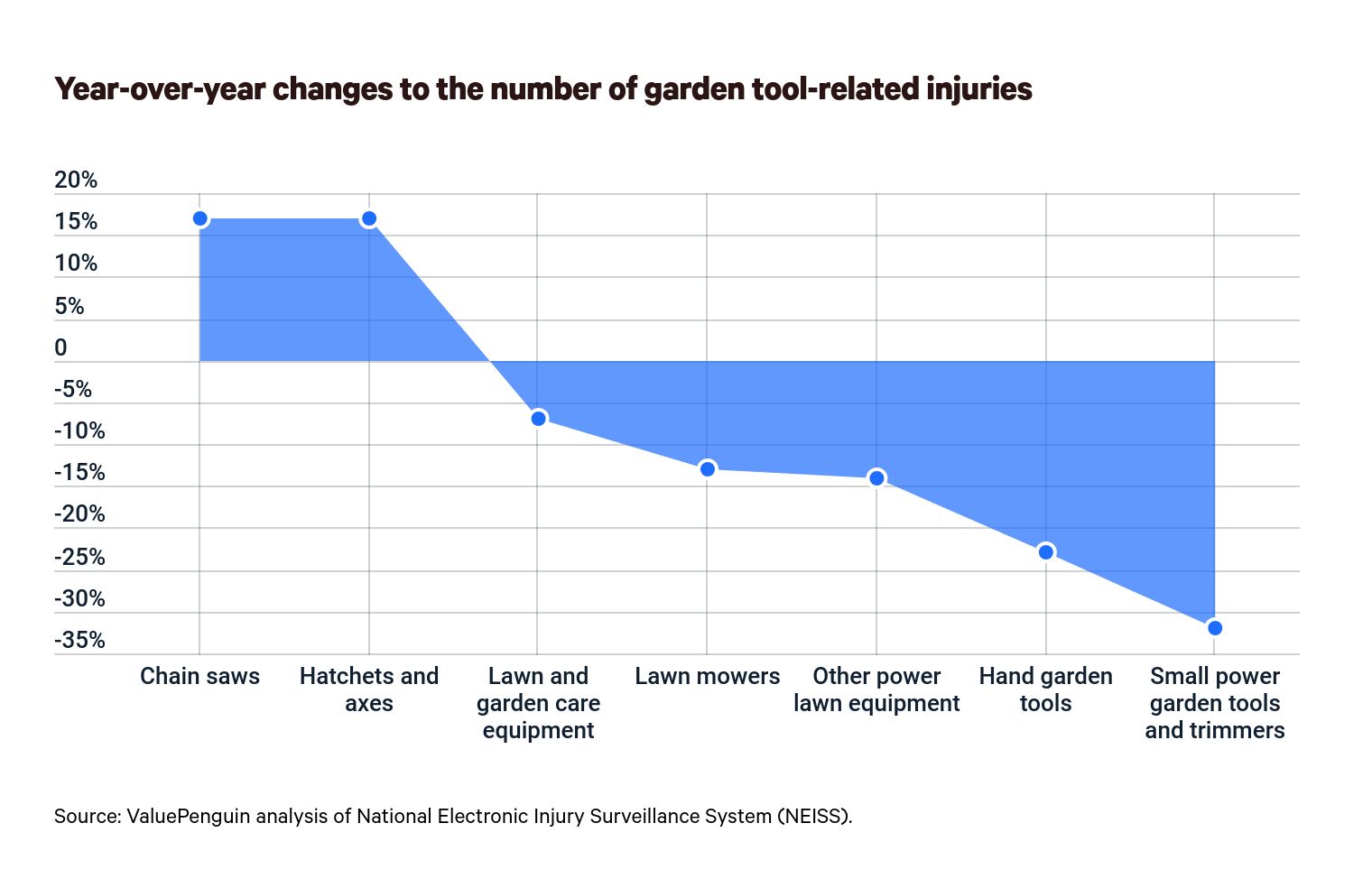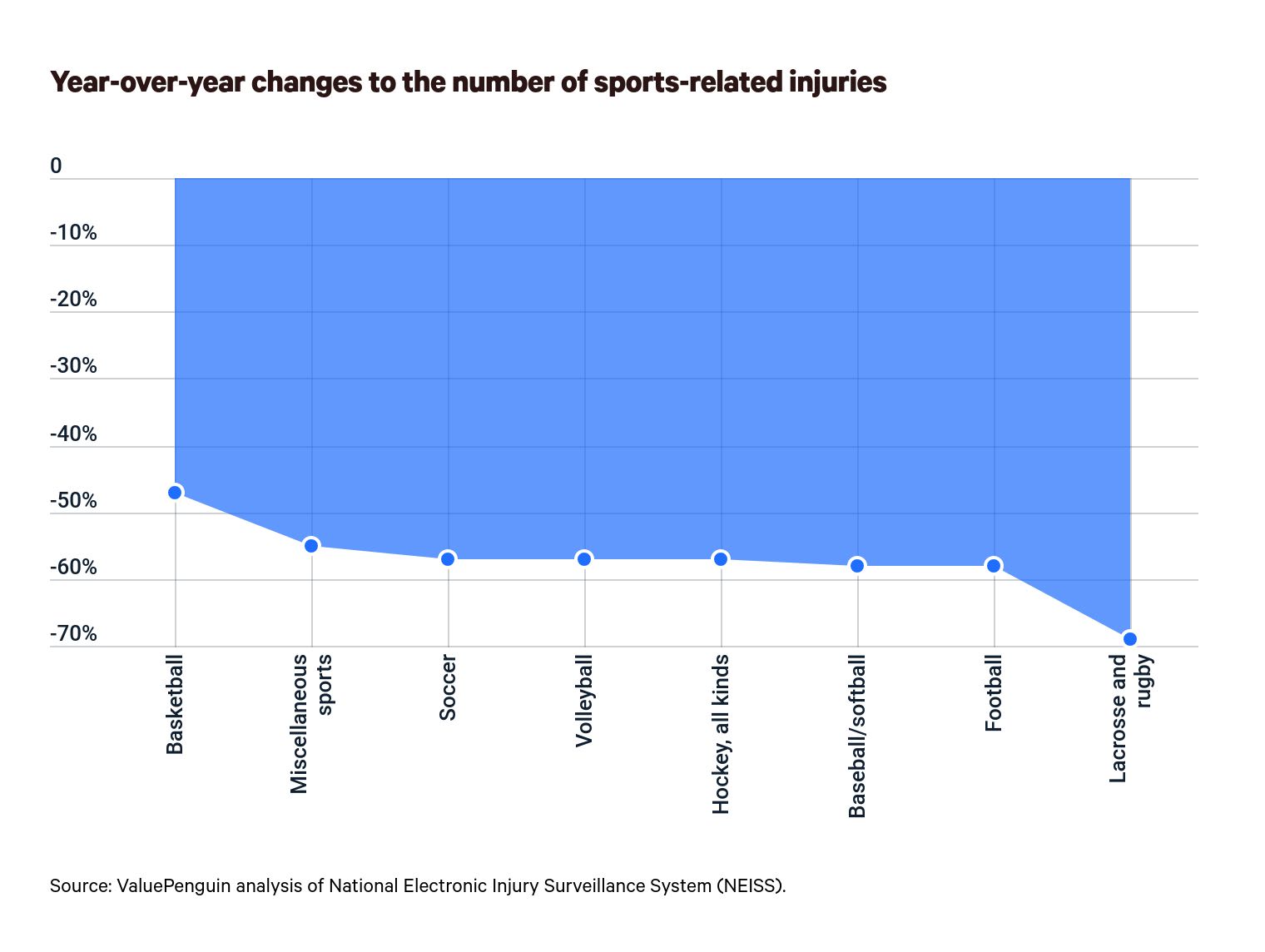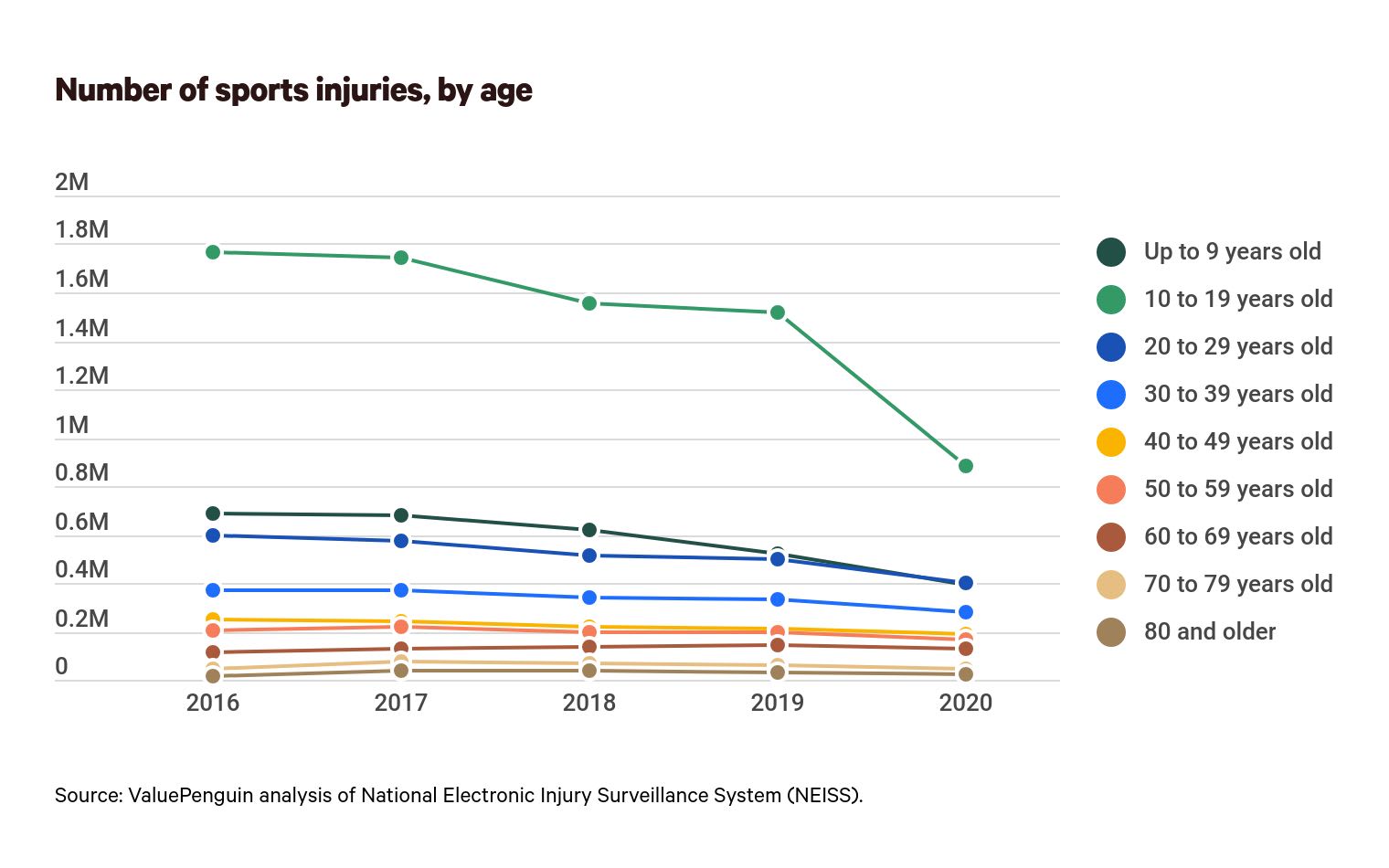Homeowners Insurance
Despite Pandemic Lockdowns That Kept Many Americans Inside, Fewer Home Improvement and Maintenance Injuries Were Recorded

An analysis of the U.S. Consumer Product Safety Commission's National Electronic Injury Surveillance System (NEISS) suggests that Americans experienced fewer injuries related to home improvement projects and around-the-house renovations that required hospital trips in 2020 than the year before, amid a pandemic that may have dissuaded injured people from visiting a hospital.
In a deep look at injuries, ValuePenguin discovered fewer injuries caused by home improvement projects, yard work and sports. However, some types of injuries within these categories led to more hospital trips in 2020 than in 2019, going against many Americans' hesitancy to visit emergency rooms.
These increases — including to the number of people injured by hot tubs, holiday supplies and barbecue grills — hint at some ways Americans spent their recreation time during the pandemic.
Key findings
- The number of injuries that hospitals treated in 2020 fell compared to the previous year. There were 29% fewer sports-related injuries, 13% fewer injuries related to recreational activities — such as hot tubbing and trampolining — 11% fewer injuries related to yard and garden equipment, and 6% fewer injuries stemming from home improvement and maintenance tools.
- Despite people spending more time renovating their homes, 2020 produced fewer documented injuries caused by home renovation tools or gardening equipment. The number of injuries caused by power tools and construction equipment fell by 6%, while injuries attributable to yardwork dropped by 11%.
- Injuries from most individual sporting events rose in 2020 compared to 2019. There was a 49% increase in the number of injuries treated in hospitals related to water sports. Injuries from skateboards and similar equipment, meanwhile, rose by 46%. A lack of team sports injuries contributed to a drop overall.
- As more Americans remained indoors in 2020, the number of injuries attributable to certain at-home perils grew. In 2020, there were 109% more injuries caused by hot tubs than the year before. Holiday supplies and barbecue grills caused 19% and 4% more injuries, respectively, than in 2019.
Despite Americans spending more money on home improvement projects, there were fewer injuries tied to work around the house
At this time last year, 72% of consumers who applied for personal loans for home improvement projects through LendingTree indicated that they intended to use the money for a home remodel or other related projects. In fact, consumers requesting loans for home improvement projects increased by 7.8% in the first week of June 2020 compared to the first week of June 2019.
Although more consumers were looking to borrow money to spend on upgrading their homes, there were fewer reported injuries related to home improvement in 2020 than in the year before. ValuePenguin found a 6% drop in cases where Americans visited an emergency department for injuries related to items used in construction, maintenance and upkeep around the house, such as manual and cutting tools, and workshop equipment.

While there were significant drops in the number of injuries caused by wires and cords (75% fewer), soldering and cutting tools (31%), hoists and jacks (28%), and nails (20%), some tools appeared to factor into more trips to emergency departments than in the year before. Miscellaneous construction materials contributed to 16% more injuries in 2020 than in the year before, while batteries and power saws were factors in 14% and 13% more injuries, respectively, than in 2019.
While injuries related to home improvement fell in 2020, there was an even steeper drop in the number of injuries related to yard and garden work.
There were 11% fewer hospital admissions where patients' injuries were related to yard and gardening tools in 2020. This drop-off wasn't universal, though, as chain saws, hatchets and axes contributed to 17% more injuries than in 2019. However, these were the only gardening implements that played a part in a higher number of injuries in 2020.
Trimmers and garden power tools factored into 32% fewer injuries than in the year before — the largest drop in this category. In general, the NEISS data shows that other power gardening tools were a factor in 14% fewer injuries in 2020 than in the year before. More specifically, there were 13% fewer lawn mower-related injuries. Even hand tools contributed to 23% fewer cases than in the year before.

The number of sports-related injuries fell drastically in 2020, with team sports seeing the most noticeable drops
There were 29% fewer sports-related and outdoor recreational injuries in 2020 than there were the year before. ValuePenguin found that the sports that saw the largest decreases were largely team-based. One reason for this could be the cancellation of many team-based sports by schools during the most devastating months of the pandemic. Injuries from lacrosse and rugby dropped sharply (by 69%), along with football, baseball and softball (58%), hockey, soccer and volleyball (57%), and basketball (47%).

Another group of recreational activities that contributed to fewer injuries in 2020 was activities that occur only in specific locations — locations that may have been closed during pandemic restrictions. For instance, bowling-related injuries fell by 90%, as bowling alleys were closed in many states for much of the year. Similarly, injuries from playground equipment fell by 46%, while there were 23% fewer injuries related to amusement parks.
The number of injuries related to golf and bicycling remained constant from 2019 to 2020. These were the only activities without a documented change.
On the other hand, some recreational activities contributed to more injuries in 2020 than in 2019. The largest increase in injuries was related to water sports, including water skiing and tubing. Cases related to these activities rose by 49%. A similar rise occurred in skateboarding-related injuries, which increased by 46%. Injuries from snow skiing, all-terrain vehicles (ATVs), fishing, horseback riding and sledding rose, too — all outdoor activities geared for individuals.
Young people were most likely to benefit from a reduction in the number of injuries related to sports in 2020. Injuries to people ages 10 to 19 fell by 42%. The second-largest fall affected those 9 and younger. This group was affected by 25% fewer injuries in 2020 than in 2019. Those ages 60 to 69 saw the slimmest year-over-year change in sports-related injuries (7%), but no group saw an overall increase.

The financial cost of another person getting injured on your property is steep, and its effects could be long-lasting
As hospitals reported fewer injuries stemming from activities that are commonly associated with warm weather, it's clear that the pandemic cooled enthusiasm for these pastimes. There were 17% fewer injuries from cases related to beaches and picnics, as well as drops in the number of people admitted to hospitals from injuries associated with porches (15%) and trampolines (14%).
Simultaneously, several at-home recreational activities were sources of more injuries in 2020 than in the year before. For instance, ValuePenguin found more injuries related to barbeque grills (4%), holiday and party supplies (19%) and hot tubs, which played a part in 109% more injuries than the year before.

As the summer season kicks off and the pandemic eases, larger gatherings are likely to be more commonplace. Consumers should be aware that if someone is injured, for example, at a barbecue or in their hot tub, they may be the target of a lawsuit.
Homeowners insurance does offer personal liability coverage to policyholders. However, data shows that the cost of home insurance increases after a liability claim by 21% on average across the states with the most injuries.
The following table shows how the cost of home insurance can increase after a lawsuit. The states featured in the table had the most preventable deaths related to falls in 2019, the most recent year data was available. If a fall took place at the home of another person, that homeowner could be sued and, as a consequence of their insurance covering the costs associated with a trial, would see higher rates in the future.
State | Annual cost | Annual cost after claim | Difference |
|---|---|---|---|
| Overall | $1,713 | $2,080 | 21% |
| Wisconsin | $1,122 | $1,444 | 29% |
| West Virginia | $1,179 | $1,486 | 26% |
| Maine | $982 | $1,309 | 33% |
| Vermont | $825 | $972 | 18% |
| South Dakota | $2,100 | $2,534 | 21% |
| Wyoming | $1,505 | $1,886 | 25% |
| Montana | $2,470 | $2,816 | 14% |
| New Mexico | $1,523 | $1,962 | 29% |
| Minnesota | $2,120 | $2,657 | 25% |
| Oklahoma | $3,321 | $3,764 | 13% |
| Rhode Island | $1,699 | $2,055 | 21% |
These states experience the top 25% most preventable deaths from falls compared to the rest of the country, per data from the National Center for Health Statistics.
Methodology
ValuePenguin compiled the data in this study from the U.S. Consumer Product Safety Commission's National Electronic Injury Surveillance System (NEISS), which estimates the total number of product-related injuries in U.S. hospitals. Researchers compared injury data from 2016 to 2020.
The sections researchers pulled from were:
- Home structures and construction materials
- Sports and recreation equipment
- Yard and garden
- Home workshop and construction equipment
- Home furnishings, fixtures and accessories
ValuePenguin's analysis used insurance rate data from Quadrant Information Services. These rates were publicly sourced from insurer filings and should be used for comparative purposes only, as your quotes may be different.
